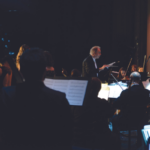It is 2020. Peyroux is speaking via Zoom, in the middle of a pandemic that has silenced all live music. In this stark context, Careless Love continues to resonate, the music and the message of those songs more relevant than ever. She repositions her laptop to reveal a poster she has kept from that evening in Vitoria in 2005. It’s a reproduction of a medieval etching of a building.
“This is El Portalon—a restaurant in a building from the 1500s that’s still standing there. We ate there ... view more »
It is 2020. Peyroux is speaking via Zoom, in the middle of a pandemic that has silenced all live music. In this stark context, Careless Love continues to resonate, the music and the message of those songs more relevant than ever. She repositions her laptop to reveal a poster she has kept from that evening in Vitoria in 2005. It’s a reproduction of a medieval etching of a building.
“This is El Portalon—a restaurant in a building from the 1500s that’s still standing there. We ate there after the show and they had amazing food. That whole evening is still with me. This concert represents a time when there was a confluence of great things happening in my life. It felt like all the work I had put into playing music for all those years was paying off. I was working with great musicians and had a great group of songs with great arrangements.
“I can’t tell you how grateful I am that we found this recording. For me, it represents the way I understood these songs at that time, how I was making music when I made Careless Love. It’s been more than fifteen years since that record came out, and I don’t think I’ve done a single concert that didn’t include at least two or three songs from it, and sometimes more. I think I’ve sung ‘Dance Me to the End of Love’ at every show. It’s part of me now.”
2004…2005…the date stamp on any music performance can be a distracting thing. The more inspired and singular the music, the less that seems to matter. Timeless is what we call music that reaches the heart and stops the clock. Few are able to attain that, fewer with consistency. For the ones who do, it can take a while navigating one’s career path to get there, to make timeless happen. Madeleine Peyroux achieved it on her second album.
Joan Osborne
Since she broke through 25 years ago with the multi-platinum Relish and its touchstone mega-smash “One of Us,” the seven-time Grammy nominee has never played it safe. Osborne has followed her restless musical heart, exploring a diverse range of genres: pop rock, soul, R&B, blues, roots rock, gospel, funk, and country – all of which can be heard on Trouble and Strife, along with the Western side of C&W and a touch of glam and disco. “For a lot of the record, we were going for a ‘70s AM radio vibe,” says Osborne. As for the lyrics, the songs “are the most political I’ve ever written,” she conveys of her first album of originals since 2014’s confessional Love and Hate. Osborne also produced Trouble and Strife, primarily recorded in her basement studio in Brooklyn and released on the label she founded in 1991, Womanly Hips.
It’s been quite the journey since the woman AllMusic.com declared “the most gifted vocalist of her generation” moved from small-town Kentucky to attend NYU film school in the 1980s. Osborne’s astounding voice drew attention when she joined the fun at open mic nights in downtown clubs, which eventually led to 1995’s Relish, “that rare breed of album where critical consensus, popular approval and enduring appeal unite,” according to American Songwriter. Since then, she’s performed with Motown’s revered rhythm section the Funk Brothers and toured with the Dead (where she first met and sang with Dylan). She’s harmonized with Stevie Wonder at the Rock and Roll Hall of Fame, duetted with Luciano Pavarotti, and co-headlined a tour with the legendary Mavis Staples. She has amassed a loyal fan base as she’s continuously traveled the country. Through it all, she sees more clearly now than ever the essential role our troubadours play.
View less














